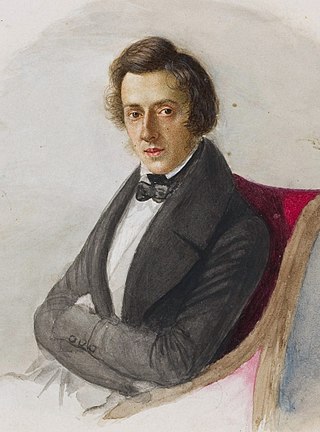
"Poland Is Not Yet Lost", also known as the "Dąbrowski's Mazurka", and the "Song of the Polish Legions in Italy", is the national anthem of the Republic of Poland.
The Music of Poland covers diverse aspects of music and musical traditions which have originated, and are practiced in Poland. Artists from Poland include world-famous classical composers like Frédéric Chopin, Karol Szymanowski, Witold Lutosławski, Henryk Górecki and Krzysztof Penderecki; renowned pianists like Karl Tausig, Ignacy Jan Paderewski, Arthur Rubinstein and Krystian Zimerman; as well as popular music artists, and traditional, regionalised folk music ensembles that create a rich and lively music scene at the grassroots level. The musicians of Poland, over the course of history, have developed and popularized a variety of music genres and folk dances such as mazurka, polonaise, krakowiak, kujawiak, polska partner dance, oberek; as well as the sung poetry genre and others. Mazurka (Mazur), Krakowiak, Kujawiak, Oberek and Polonaise (Polonez) are registered as Polish National Dances, originating in early Middle Ages. The oldest of them is Polonaise that comes from the Medieval pageant dances and it was originally called "chodzony", a "walking dance".
The mazurka is a Polish musical form based on stylised folk dances in triple meter, usually at a lively tempo, with character defined mostly by the prominent mazur's "strong accents unsystematically placed on the second or third beat". The mazurka, alongside the polka dance, became popular at the ballrooms and salons of Europe in the 19th century, particularly through the notable works by Frédéric Chopin. The mazurka and mazurek are often confused in Western literature as the same musical form.
The polonaise is a dance of Polish origin, one of the five Polish national dances in 3
4 time. Its name is French for "Polish" adjective feminine/"Polish woman"/"girl". The original Polish name of the dance is Chodzony, meaning "the walking dance". It is one of the most ancient Polish dances representing Polish cultural dance tradition. Polonaise dance influenced European ballrooms, folk music and European classical music.

Henryk Wieniawski was a Polish virtuoso violinist, composer and pedagogue, who is regarded amongst the most distinguished violinists in history. His younger brother Józef Wieniawski and nephew Adam Tadeusz Wieniawski were also accomplished musicians, as was his daughter Régine, who became a naturalised British subject upon marrying into the peerage and wrote music under the name Poldowski.
Tempo rubato is a musical term referring to expressive and rhythmic freedom by a slight speeding up and then slowing down of the tempo of a piece at the discretion of the soloist or the conductor. Rubato is an expressive shaping of music that is a part of phrasing.

Stanisław Moniuszko was a Polish composer, conductor and teacher. He wrote many popular art songs and operas, and his music is filled with patriotic folk themes of the peoples of the former Polish–Lithuanian Commonwealth. He is generally referred to as "the father of Polish national opera". Since the 1990s Stanisław Moniuszko is being recognized in Belarus as an important figure to Belarusian culture as well.
Musical nationalism refers to the use of musical ideas or motifs that are identified with a specific country, region, or ethnicity, such as folk tunes and melodies, rhythms, and harmonies inspired by them.
The Mazur is a Polish folk and ballroom dance with origins in the region of Mazovia. It is one of the five Polish national dances.

The oberek, also called obertas or ober, is a lively Polish dance. Its name is derived from the Polish obracać się. It consists of many dance lifts and jumps. It is performed at a much quicker pace than the Polish waltz and is one of the national dances of Poland. It is the second-most popular dance in Polish-American music, after the polka.

The Krakowiak or Cracovienne is a fast, syncopated Polish folk dance in duple time from the region of Kraków and Lesser Poland. The folk outfit worn for the dance has become the national costume of Poland, most notably, the rogatywka peaked hat with peacock feathers.
The Mazurkas, Op. 6 are Frédéric Chopin's first set of mazurkas published during his lifetime. They were composed in 1830–1831 and were published in 1832. The set was dedicated to Grafin Pauline Plater.

Polish folk dances are a tradition rooted in ten centuries of Polish culture and history. Many of the dances stem from regional customs and historical events and are distinct from Czech, Slovak and Germanic styles. National dances include formal ballroom or ballet elements. Nowadays, the dances are only performed during major events, holidays or in tourist-oriented public spaces.
Over the years 1825–1849, Frédéric Chopin wrote at least 59 compositions for piano called Mazurkas. Mazurka refers to one of the traditional Polish dances.

Mazurkas, Op. 59 are a set of three Mazurkas for solo piano by Frédéric Chopin. The set was composed and published in 1845.

Mazurkas, Op. 33 are a set of four Mazurkas for piano by Frédéric Chopin, composed and published in 1838.

Mazurkas, Op. 17 is a set of four mazurkas for solo piano by Frédéric Chopin, composed in 1832–1833 and published in 1834. The set was dedicated to Lina Freppa.

The Op. 63 Mazurkas by Frédéric Chopin are a set of three mazurkas for solo piano written in 1846 and published in 1847. These were Chopin's last set of mazurkas published during his lifetime. They demonstrate the composer's "late" style and may suggest a maturity of his emotional approach to the mazurka as a musical form.
European dances refers to various dances originating in Europe. Since Medieval ages, many European dances tend to be refined, as some are based on the court dances of aristocrats.
Kujawiak is a Polish folk dance











